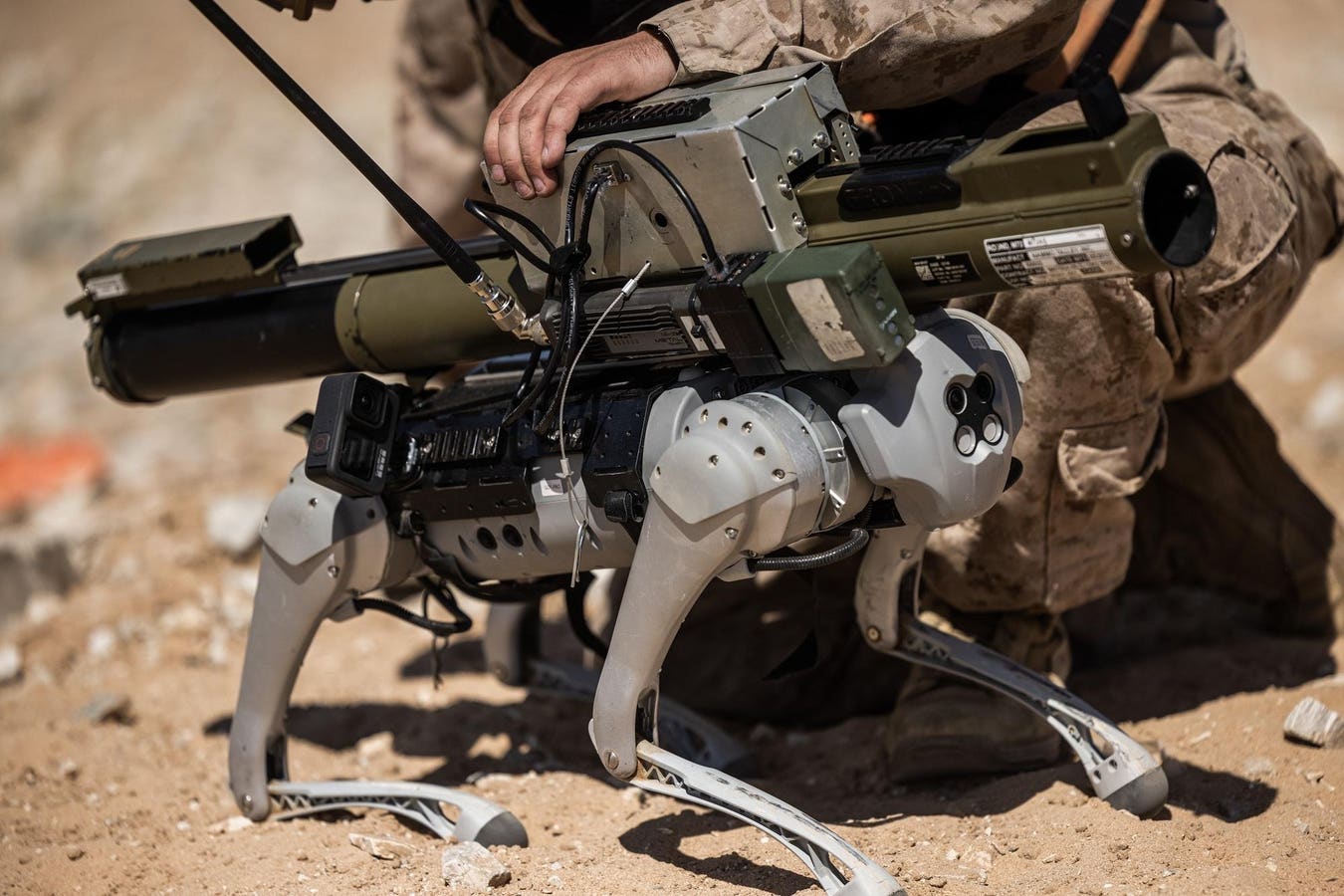Marines with the Tactical Training and Exercise Control Group recently conducted a proof-of-concept test of a quadruped robot firing an M72 rocket launcher, according to a Marine Corps news release. Last year a St Petersburg company offered a rocket-armed robot dog to the Russian military; this appears to be based on the same robot used by the Marines which is a type made in China.
The demonstration, carried out at a firing range at Twentynine Palms in California, was focused on the Kairos remote trigger mechanism rather than the robot. This offers a safe, reliable means to fire a weapon from a distance. The robot dog (which the Marines call a ‘robotic goat’) was simply a convenient platform used to test different tactical ways of using the trigger, and appears to have been purchased as an off-the-shelf commercial item.
This is the latest of many efforts to weaponize robot dogs. These have ranged from demonstrations like the polemical Spot’s Rampage – an art installation with a paintball gun to highlight the risks of armed robots – and the lighthearted I Did A Thing video on YouTube of a home-made rifle robot to more serious efforts. These include a Ghost Robotics quadruped with a 6.5mm rifle pod from Sword Defense , reportedly able to hit human-sized targets from several hundred meters.
A number of videos originating from China also show armed Unitree robots, like the one used by the Marines. These seem to be largely improvised projects, in the same spirit as the many hastily-assembled but highly effective drone bombers used in Ukraine. The company does not have a specific military model (yet).
The robot in the I Did A Thing video is almost knocked over by the kick of the rifle it fires; with its minimal recoil, the M72 rocket launcher is a simpler weapon to integrate. You can even mount one on a drone.
Putting the weapon on a remote platform able to maneuver close to the enemy and wait until needed makes it a mobile and reusable version of the rocket-firing off-route mines seen in Ukraine.
“Instead of having a Marine handle the weapon system, manipulate the safeties, we could put a remote trigger mechanism on it that allowed it to all be done remotely,” 1st Lt. Aaron Safadi, said in the release. “The Marine could be behind cover and concealment, the weapon system could go forward, and the Marine could manipulate the safeties from a safe place while allowing that weapon system to get closer to its target.”
The US military is wary of using Chinese hardware and there is a longstanding ban on the use of drones from Chinese maker DJI. Both sides have used huge numbers of DJI quadcopters in the conflict in Ukraine for reconnaissance, artillery spotting and dropping bombs. However, possible security risks –DJI is answerable to the Chinse government and might provide information about, for example, drone locations – means that the U.S. no longer use them. The Blue UAS program provides U.S. government operators with alternatives to Chinese made-drones.
The Unitree Go1 robot was probably chosen because it is cheap and easily available. You can buy one online for under $3,000 plus shipping, making it more expensive than most drones but with a heavier payload. More sophisticated quadrupeds are more expensive; Boston Dynamics Spot reportedly sells for around $60k, making it much less expendable. In addition, Boston Dynamics have strongly denounced any attempts to use their robots for military purposes and will not support attempts to attach weapons to them. The U.S. military is testing unarmed Ghost Robotics platforms for base patrols.
A mobile platform for remote controlled weapons makes a lot of sense to keep troops out of harm’s way. The US military has been exploring this concept since the 1980s, but while armed drones are now common, armed ground robots have been less successful. This appears to be partly due to concerns about rogue robots and the potential for friendly fire incidents, which undermined U.S. Army efforts to field an armed robot called SWORDS in Iraq.
The Marine Corps may not field armed robots any time soon, and if they do the hardware will be American. But the demonstration shows that the technology to put a robot in the front line not only exists now but can easily be implemented. Further, it can, like drones in Ukraine, can be acquired at prices low enough for the soldiers themselves or their supporters. It may not be as fancy and sophisticated as Russia’s Uran-9 robot tankette, but the rocket-armed robot dog may be a simple and practical way of fighting at long range.
Read the full article here





